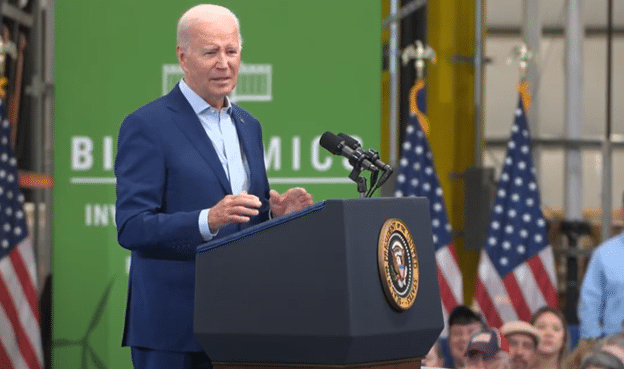
Consumer inflation in the U.S. economy remained sticky in July as prices have climbed 3.2 percent the past twelve months, up from 3 percent in June, amid climbing oil prices and a weakening dollar, according to the latest data from the Bureau of Labor Statistics.
Prices had cooled to 4.9 percent in April, 4 percent in May and 3 percent in June, following the price surges of 2021 and 2022, when consumer inflation first rose above 5 percent annualized in June 2021 to 5.4 percent, up to 7.5 percent by Jan. 2022 immediately prior to Russia’s invasion of Ukraine, and peaking at 9.1 percent in June 2022.
The news comes as the Federal Reserve hiked interest rates on July 26 to 5.25 percent to 5.5 percent last month amid concerns over continued upward pressure on prices following the economic lockdowns and production slowdowns of the Covid recession and Russia’s invasion of Ukraine that exacerbated the global supply chain crunch.
And it comes in spite of passage of the Inflation Reduction Act in Aug. 2022, emphasizing that the U.S. and global economies are much larger than the actions that can otherwise be taken by the government counteract forces beyond its control.
Just yesterday, on Aug. 9, President Joe Biden was touting the turnaround at a campaign reception in Albuquerque, N.M., stating “We’re in a situation where inflation is the lowest in two years — at 3 percent…” So much for that. Now, prices are rising again.
But it also emphasizes the premium that is still placed on the U.S. dollar itself as the world’s reserve currency. After a great strengthening of the dollar in 2022 amid a flight to safety into U.S. dollar-denominated assets including treasuries after the war in Ukraine began, the dollar has been weakening on an annualized basis since May, according to the Nominal Broad U.S. Dollar Index compiled by the Federal.

Generally, when the dollar is strengthening, it can put downward pressure on asset prices particularly, but also sees tail-end impacts on consumer inflation when sustained, and when it is weakening, it can boost asset prices denominated in dollars, similarly putting upward pressure on consumer prices over time.
With the weakening dollar, U.S. light sweet crude oil has jumped from $67 a barrel at the end of June to now $83 a barrel today. This jump in prices could factor into next month’s inflation report as well when the oil factors into gasoline prices.
The 2021 and 2022 inflation came about in the first place amid by a dramatic jump of the M2 money supply, which grew by almost $7 trillion from 2020 to 2022 to $22 trillion thanks to Congress spending about that much and the national debt skyrocketing by $8 trillion. This weakened the dollar at the time.
Then, when the Fed began hiking interest rates, charging more interest to banks who in turn pass on interest rate hikes to consumers, it reduced the money supply to $20 trillion.
With the dollar weakening again, if the economy overheats again from the sticky inflation, that might cause the Fed to keep interest rates elevated until prices come down on a sustained basis, unemployment goes up driving down demand, or both.
Speaking at a press conference following the central bank’s rate hike on July 26, Federal Reserve Chairman Jerome Powell stated, “My colleagues and I are acutely aware that high inflation imposes significant hardship as it erodes purchasing power, especially for those least able to meet the higher costs of essentials like food, housing, and transportation… We have been seeing the effects of our policy tightening on demand in the most interest-rate-sensitive sectors of the economy, particularly housing and investment. It will take time, however, for the full effects of our ongoing monetary restraint to be realized, especially on inflation. In addition, the economy is facing headwinds from tighter credit conditions for households and businesses, which are likely to weigh on economic activity, hiring, and inflation.”
Powell added a word of warning, “Reducing inflation is likely to require a period of below-trend growth and some softening of labor market conditions.”
Unemployment is still near record lows, currently at 3.5 percent in July and the Federal Reserve in June projected it to keep rise steadily to 4.1 percent this year and up to 4.5 percent in 2024, an implied 1.3 million jobs losses between then and now, as it sees inflation continuing to cool off from its current levels. And it only sees 1 percent inflation-adjusted economic growth in 2023, 1.1 percent in 2024 and 1.8 percent in 2025.
However, those GDP estimates were from a month ago, and the minutes for the Fed’s July meeting are not yet available. Since then, the Bureau of Economic Analysis reported 2.4 percent inflation-adjusted growth in the second quarter, following a 2 percent increase in the first quarter. So, to hit just 1 percent growth for the entire year would require almost no growth or negative growth going forward.
What it all might mean, especially if inflation starts running up again on a sustained basis, is it could be time to reset our clocks in terms of any downturn or slowdown on the horizon. If demand remains high, so will prices, and that might at least temporarily forestall the softening of the labor market that Powell foresees. As usual, stay tuned.
Robert Romano is the Vice President of Public Policy at Americans for Limited Government Foundation.





